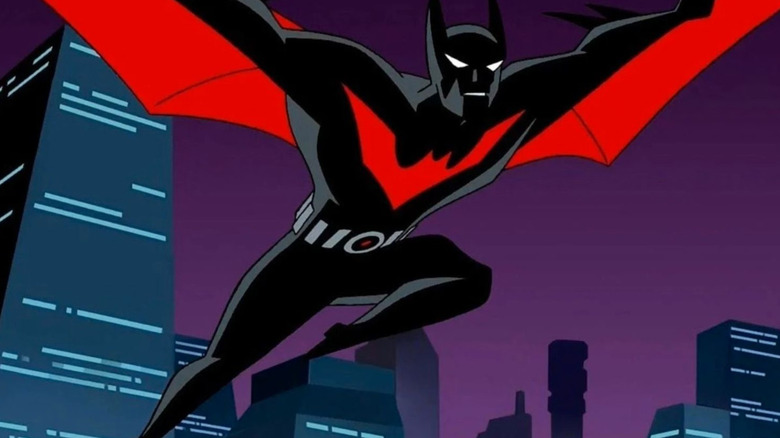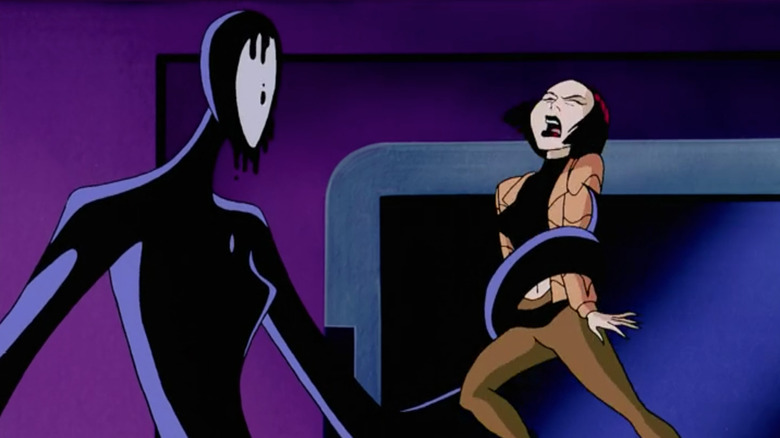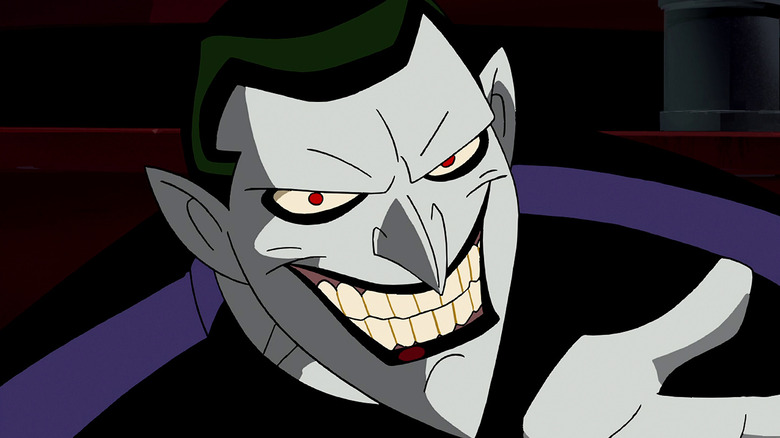Reusing Tried-And-True Villains Was Never An Option For Batman Beyond
Surely the most daunting challenge in front of DC Studios' new chiefs, James Gunn and Peter Safran, is reconciling the many different on-screen incarnations of DC characters we've gotten over the years. At the same time that fans of director Matt Reeves worry for the future of his already-greenlit sequel to "The Batman," the Snyderverse continues on through the law of inertia, Warner Bros. is trying to decide what to do with "The Flash" star Ezra Miller, and we have more Jokers than we can count.
In times like these, it's fitting to look back at a show like "Batman Beyond," which was able to borrow from past Batman and DC properties, while also reinventing them. Through its shared DNA with "Batman: The Animated Series," preserving an older Bruce Wayne as a mentor, and maintaining Kevin Conroy's signature voice, the show feels familiar. Yet, it's groundbreaking in how it adapts the Batman mythos for a digital generation.
Much of this comes from the animators' reimagining of Gotham City as a futuristic cyberpunk metroplex, but even more comes from the character designs. Batman's suit, for example, is as close to Iron Man's as it is to Bruce Wayne's, nearly erasing the universal rule that Batman has no superpowers. And to give a fully fresh coat of paint, with some gigantic exceptions, we get a largely updated rogues' gallery for Terry McGinnis that is distinct from — but spiritually tied to — his mentor Bruce's. The genius of this stylistic approach is carried out by borrowing basic ideas from legendary villains, leading to "Batman Beyond" creating something new.
The Timm technique
In a December 2020 interview with IGN, character-designer-turned-director James Tucker, who also worked on "Superman: The Animated Series" and "Static Shock," recalled early instructions his team received from "Batman Beyond" creator and producer, Bruce Timm:
"Bruce pulled all the artists who could do it into a room and said, 'We need villains.' He basically just threw it out there. We developed the show in a room. It was me, Glen, Shane Glines, a few others, and we were just throwing out ideas and literally just drawing. Everything was coming out fresh, because Bruce didn't want us to just do futuristic Clayface. He wanted completely original characters."
Luckily, Timm made one important allowance: allowing the creature designers to use former canonical motifs, with an added kooky, futuristic spin. Following these directions, the illustrators and animators produced some of the show's most memorable villains, including one of Terry's greatest recurring rivals, Inque.
"Out of that idea, James Tucker came up with the Inque character. He literally just drew this blobby, weird, shape-shifting character, and then wrote I-N-Q-U-E, which I thought that was kind of a neat way to spell it. So that's our Clayface, that's our shape-shifting, weird character, but A, it's a female, and B, she's stylish and elegant, not just a pile of crap. That set the pattern for how we came up with all of the other characters."
In a similar fashion, season 1's Terrific Trio is a nod to the Terrible Trio from the comics and "Batman: The Animated Series," which consists of three scientists turned criminals, but with powers resembling the Fantastic Four. For Derek Powers, aka the radioactive man Blight, the show also has its obligatory Bruce Wayne counterpart.
Sticking to the script
Admittedly, some of the best villains in "Batman Beyond" are those who resurface from Batman's past, like when Mr. Freeze returns in "Meltdown" (season 1 episode 5), or when the Joker resurrects himself in the 2000 animated film "Batman Beyond: Return of the Joker." The show also brings back the League of Assassins with new faces.
The fusion of Batmans both past and present is fully represented in the show's generic horde of goons called the Jokerz. It may be a trope to include a gang of evil clowns in the cast, but this was useful for establishing the futuristic city before us as Gotham City, and not Los Angeles a la "Blade Runner: 2049." According to the 2020 IGN interview with James Tucker, the Jokerz are emblematic of the larger creative process:
"I designed the majority of the Jokerz at the start of the series, and then later we started filling in new Jokerz as we went along. Everything that was in that show came from sitting in that room and talking. Thank God we had been all working together for the past five years already...You couldn't create a show from whole cloth with people who were fresh to each other and didn't know each other's strengths and weaknesses. There was just such a synergy and Bruce just trusted us. I don't know, it was great. I've never had a working situation quite like that."
By building on what came before, "Batman Beyond" celebrates the tradition of comic books and animation. It is both a satisfying epilogue for Bruce Wayne and a novel reconstruction of Gotham. If the show is ever adapted for live-action during the next unpredictable phase of DC Studios, it offers a deep well of original characters that, while inspired by Batman's history, have taken on a life entirely of their own.


